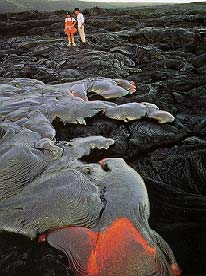| ________________
CM . . .
. Volume VIII Number 9 . . . . January 4, 2002
exerpt:
Volcano is the first in the new Kids Can Press "Disaster" series. Its newspaper-style cover and the similar headline story format throughout the book catch the attention of young readers. Cynthia Pratt Nicholson, author of several nonfiction titles such as The Stars and The Planets, provides children with easy-to-read information on a topic of high interest - volcanoes. By using a headline for each chapter, Nicholson draws the reader's attention to different aspects of the study of volcanoes, from their mechanics to their power of destruction. In reading Volcano, children explore how volcanoes are created, how they erupt and why scientists risk their lives to study this phenomenon. They learn about famous volcanic eruptions and why the term "disaster" is often included in the headlines.
In using a newspaper layout for Volcano, the author presents information on this topic in a dramatic narrative style. This style is familiar to young readers, assists in their comprehension of the information and engages their attention. Simple diagrams, charts and a glossary also help to explain the science of volcanoes. The numerous, well-selected photographs with accompanying captions enhance the text. The book includes a table of contents, but, the since the chapter headings are headlines, such as "When Time Stood Still," this feature does not assist a reader looking for a specific topic. However, the index will help in locating keywords. An interesting and appealing feature of the book is the inclusion of hands-on activities. The materials needed are household items, and the activities help the young scientist discover how a volcano is created and how it works. Volcano will be a useful resource for understanding one of the great forces of nature. Not only will its readers gain information about how volcanoes are created and the events leading to their eruption, they will also learn about the scientists who study them. The true-life stories add interest and understanding to this disaster. They also explain why volcanologists risk their lives to make better predictions in the hope of saving lives. Volcano will lead many young readers to explore this fascinating topic further. Highly Recommended. Janice Foster is a teacher in Fort Garry School Division in Winnipeg, MB.
To comment on this
title or this review, send mail to cm@umanitoba.ca.
Copyright © the Manitoba Library Association. Reproduction for personal
use is permitted only if this copyright notice is maintained. Any other
reproduction is prohibited without permission.
Published by
NEXT REVIEW |TABLE OF CONTENTS FOR THIS ISSUE - January 4, 2002.
AUTHORS
| TITLES | MEDIA REVIEWS
| PROFILES
| BACK ISSUES
| SEARCH | CMARCHIVE
| HOME
|

